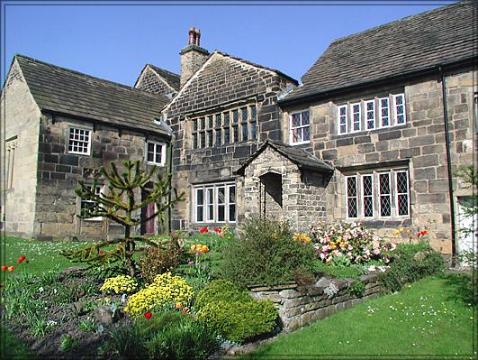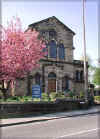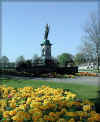Yorksview

| Calverley is one of those blackened stone Pennine
villages like Haworth and Thornton. It hasn’t outgrown itself and merged
into its neighbours like Pudsey and Horsforth. It is leafy and still
surrounded by fields. It lies between Leeds and Shipley. Though closer to
Bradford it is officially part of Leeds. It is on high ground above the Aire
opposite Rawdon. Once it had woollen mills providing work for its people; now,
as elsewhere, the old work has gone but the village prospers as a prime
residential address. It is an old village, mentioned in the Domesday Book as
an area of waste like so much of the North of England after William the
Conqueror’s ruthless subjugation of the area.
There are many old cottages, some fine Victorian and Edwardian family houses and, as always, newer properties on the fringes of the village. There are some allotments and unmade roads, both of which could feature in Disappearing Yorkshire. There are two golf courses in Woodhall Hills and spectacular views across Leeds and Bradford and beyond. There are good walks in Calverley Woods and down by the river. The village is served by two public houses, the Thornhill Arms and the New Inn. |
Church and house |
St Wilfrid’s Church has some Norman elements but largely dates from the thirteenth and fourteenth centuries. It is in the Decorated style which is unusual in this area. There is old glass in the east window, an altar which is Elizabethan and a Jacobean cover on the font. Outside in the north wall are stones carved with crosses, dating from the twelfth and thirteenth centuries and believed to be early memorials of the Calverley family. Others lie in the churchyard. There is the grave of a Royalist who fell in the Civil War and that of a giant man, Benjamin Cromach, who was said to have needed eight feet of English earth when he was buried.
The Calverleys lived here for six centuries. Unfortunately the best known is the most tragic. Sir Walter Calverley of Calverley Old Hall was the subject of a play published early in the seventeenth century as being by William Shakespeare though that has since been disproved. Sir Walter, the Lord of the Manor, having lost his fortune and presumably his mind, murdered two of his children and his wife, whom he had never loved because instead in his youth he had fallen for a humble village girl who was not a suitable match. After some time incarcerated in York Castle he was put to death in a most unpleasant way – pressed to death. Sir Walter is - surprise, surprise – said to haunt the Old Hall brandishing a bloodstained knife. His ghost has been seen on horseback in the surrounding countryside. (You have been warned if you are planning late night shopping at Sainsbury’s at Greengates). Apparently an attempt to exorcise the ghost failed. These things are not always straightforward, you know.

Calverley Old Hall
At the entrance to Calverley’s park is an impressive war memorial of a woman in bronze holding a wreath. (There is another fine memorial down the road at Greengates). A beacon was lit here to mark the start of the year 2000 and again twelve months later as the third millennium began. No doubt it will be lit again in 2002 to celebrate fifty years since Elizabeth II became Queen.
|
Houses |
Next to the park is an austere no-nonsense Methodist chapel of almost industrial proportions. It dates from 1872. As well as worshipping on Sundays, its members are kept from being idle at other times. The notice board outside lists the following: Monday – Scouts; Tuesday – Bible study; Wednesday – Women’s Fellowship; Thursday – Thursday Club (well, there wouldn’t be much point having it any other day); Friday – Choir practice; Saturday – Coffee morning. Praise the Lord, keep busy and none of those bells and smells. |
I spoke to Jack Calvert, a well-known resident of Calverley. There’s not much Jack doesn’t know about this part of Yorkshire. Seen it all has Jack. ‘Tell me about Calverley, Jack,’ I said. Jack thought. ‘It’s a nice quiet place’, he said. And that was it. Jack’s a Yorkshireman.
JDB
Click the images below to enlarge





